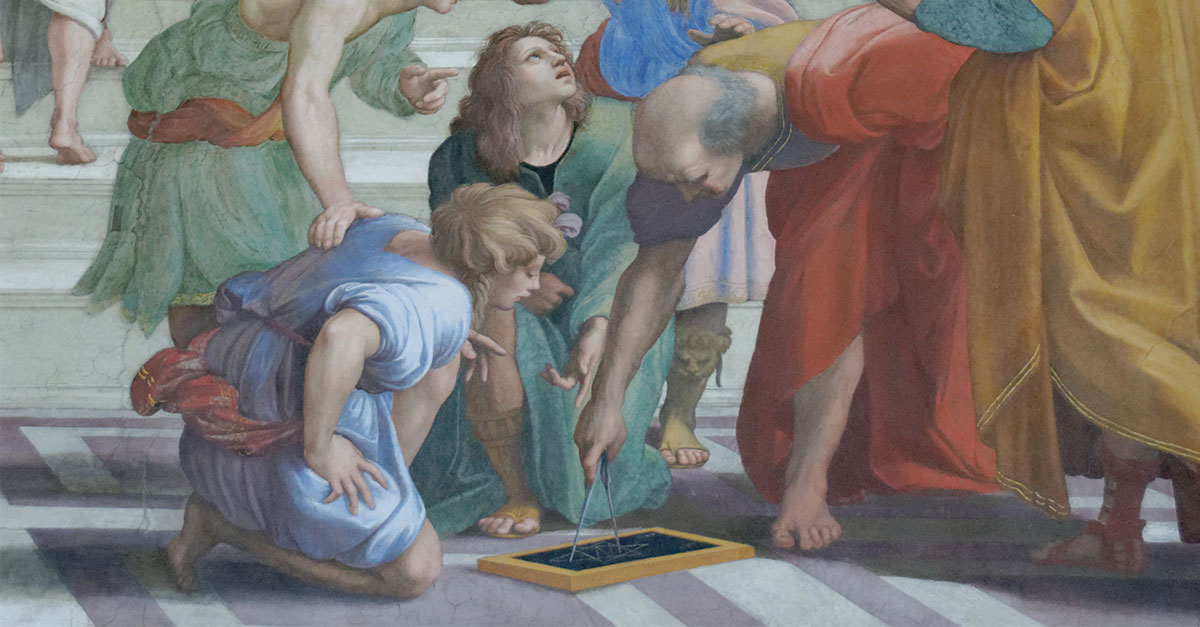
When it comes to classical education, mathematics is often the Cinderella sister: she lives in the home along with her sisters Literature, Language and History, but she’s not really considered part of the family. There are at least two main reasons for math’s odd position in classical education.
First, for us moderns it can be hard to think classically about math as our worldview is often decidedly different from the ancients. Moreover, most of us do not approach math education like Abraham Lincoln who worked his way through Euclid’s The Elements as a self-taught unschooler. And even if we did approach math education in this way, we recognize that innovation in mathematics didn’t end with Euclid and the Greeks, and there is a need to combine study in Euclidean geometry with study in other fields of mathematics, including algebra and calculus.
The second reason math doesn’t fit neatly within classical education is because the classical education movement, while being rightfully skeptical about 20th century math education, has not been critical enough about the lack of emphasis on mastery in the 20th century models.
As will be explored in more depth in this article, a trend in one particular strain within modern American Christian classical education, inspired by Dorothy Sayers’ essay The Lost Tools of Learning, is to divide math into grade levels that are thought to correspond with both the classical trivium and child development theory. In this model, elementary kids are grouped in the grammar stage and drilled in math, middle schoolers are put in the logic stage and taught the abstract symbolism in which mathematics is expressed, and high schoolers are placed in the rhetoric stage and taught the conceptual “whys” of math. One problem with this approach is that it isn’t faithful to the classical trivium model. Perhaps more importantly, the assumed child development theory it is based on is flawed.
In this article, I will survey the history of math education, demonstrate why the Sayers approach to math is in need of modification, and explore an alternative model for classical math education that draws from the insight of deeper sources than Sayers.
History: How Has It Been Applied?
Classical education has its origins in the interplay of hellenistic and Christian thought, culminating in the formal establishment of the trivium and quadrivium in the university model that dominated the Middle Ages.
Many of the ancient Greeks promoted the idea of four major subjects (later identified as the quadrivium), though recall that Plato infamously advocated for the banishment of poetry (which would have included Homer’s The Odyssey, by the way). It wasn’t until the Carolingian Renaissance in the eighth century that the trivium was formally established as the foundation for learning upon which the quadrivium should build.
It was during this time that the concept of a “liberal arts education” composed of seven subjects came to fruition under the influence of Charlemagne’s advisor Alcuin of York (Source). Alcuin’s program makes obvious sense. The texts used in the more specialized technical fields (quadrivium) were all written in classical Latin and Greek, so fluency in Latin and Greek (“grammar”) was a first requirement, followed closely by proficiency in rational argumentation as the preferred method of learning in the university classrooms (“logic” & “rhetoric”).
The modern classical education movement has largely been inspired and influenced by the 20th century essayist and educator Dorothy Sayers and her essay “The Lost Tools of Learning.” In the 20th century, math education in the West shifted its emphasis from geometry to algebra. This shift reflected the modern philosophy of educators such as John Dewey. Whereas in England, the norm had been for students to study Latin and Greek, the latter language preparing them for Euclid and thus geometry, the new education model concerned itself exclusively with practicality and usefulness. Another aspect of this new shift in education was that 19th-century and early 20th-century educators often mistakenly conflated rote memorization with deep understanding. Sayers’ essay is largely a response to both this increasing fragmentation of education and the corresponding lack of attention paid to history and the wisdom found in classical texts.
Current Times: How It Is Being Misapplied
Dorothy Sayers provides a helpful summary of the ordering of the trivium. The student first learned “the structure of a language” by which she meant learning “what it was, how it was put together, and how it worked.”
Secondly, the student learned “how to use language” which included “how to define his terms and make accurate statements; how to construct an argument and how to detect fallacies in argument.” Finally the student learned “to express himself in language—how to say what he had to say elegantly and persuasively.”
The problem comes when Sayers attempts to tie the trivium in her signature “rough-and-ready fashion” to a theory of child development that she has invented based on anecdotal observation and her memory of being a child. She calls her three stages the Poll-Parrot, the Pert, and the Poetic: in the parrot stage, the child memorizes and repeats back, much like a parrot, while in the Pert stage, the (preteen) starts to talk back (arguing as a form of learning), and in the Poetic, the (misunderstood) teen learns to harness creativity leading to self-expression. This description is very much not a caricature of Sayers’ writing, but if you don’t believe me, just read her essay.
If it sounds like I’m being unduly critical of Sayers, it’s worth noting that she herself admitted her limitations, writing that “my views about child psychology are, I admit, neither orthodox nor enlightened.” And as Martin Cothran, an editor for Memoria Press, writes:
Nor did Sayers herself ever explicitly identify her states of development as classical education—in her speech or anywhere else. In fact, the term ‘classical education’ does not even appear in her essay.
This isn’t to say that Sayers’ essay is not valuable, but rather to say we can and should be critical of it in those places where it serves as an impediment to actual learning.
Unfortunately, Sayers’ error of putting K-12 students into these three boxes has been repeated by many in the modern classical education world. For example, in her book on classical education, Leigh Bortins, founder and CEO of Classical Conversations, writes of “grammar school students” preparing to move into “dialectic, abstract math” and advocates for an emphasis on drilling and memorization for those grammar students. This error suggests that students can be grouped into trivium-based stages, such that elementary kids are drilled in “grammar” (math facts) but not given the opportunity to benefit from the dialectical and rhetorical aspects which would allow them to fully master math, both conceptually and practically.
In practice, this means that children’s’ first experience of math is sheer memorization that lacks any meaningful context and that is divorced from conceptual development. Teaching elementary students to memorize math facts without the underlying context is like having them memorize Latin words without learning what those words mean. To be clear, drilling and repetition is important for learning math because it can increase fluency and simplify a student’s ability to reach solutions as math concepts become more complex, but it is not sufficient as a standalone method regardless of the student’s age or development level.
In many ways, curriculum corresponding to the Sayers’ Parrot/Grammar stage, such as Saxon Math, is what has replaced Euclid in modern math education, in public school as much as in many private and homeschool settings. Whereas Euclid’s model in his book The Elements is to begin with axioms and build conceptual knowledge in the form of proofs following from those axioms, the Saxon model has students learn procedures in order to manipulate equations with the goal of producing answers. Neither model is fully sufficient. The Euclid model, at least as it is often practiced in Great Books programs, is akin to a chemistry student who reads a textbook on the periodic table but never participates in a lab experiment. The Saxon model is akin to a student learning how to replicate a chemical reaction in a lab without ever learning about those chemicals and why their combination produces the reaction it does.
Summary of the Proper Approach
While Bortins repeats Sayers’ error, she also recommends a model that, inasmuch it modifies Sayers’ approach, is much more effective. In this model, students emulate all three aspects of the trivium through the course of working through a single math problem. She writes:
Each problem provides a micro-example for practicing the skills of learning. The students demonstrate that they have mastered the math terms used (grammar) and that they understand the rules and strategy of the problem so they can solve the problem (dialectic.) Finally, they explain how they solved the problem rhetorically, demonstrating that they understand the algorithm.
This is remarkably congruent with the model we employ at Math-U-See which encourages students to “build it, write it, say it, and teach it back” as the method for both achieving and demonstrating mastery of each new concept.
Grammar (the language of math), logic (the why of math), and rhetoric (the application of math) are three distinct but complementary and intermingling disciplines, and each of these disciplines is worth studying. If we are to teach math classically, we ought not attempt to split the trivium into fragments, but to tap into its power as a cohesive and unified foundation of knowledge. The best way to model math education on the trivium is thus to utilize each discipline (grammar, logic, rhetoric) for each concept being taught.
The Enduring Value of Classical Education
In the context of this article, I see two main benefits to classical education:
1) Understanding historical ideas in their historical context.
In his beloved essay “On The Reading of Old Books” C.S. Lewis points out that while ancient writers likely had many mistaken beliefs, it is much less likely that they share the same mistaken beliefs that we have. In other words, since writers of our own age are likely to share the same blind spots, reading old books can help us see and correct errors in our own thinking.
Math-U-See doesn’t really offer this benefit, but neither does any homeschool math curriculum so far as I know. As an example of what I have in mind, there are curricula that teaches science through history including Susan Wise Bauer’s The Story of Western Science and Jay Wiles’ new elementary science curriculum.
Of course, for those educators or students who are audacious enough to try it, Euclid’s The Elements is readily available both in print and online, and often is published with illustrations making it more accessible. You can also supplement your math with intriguing books on history such as The Abacus and The Cross which profiles Gerbert of Aurillac, a medieval Pope and one of the leading mathematicians of his day.
2) Correcting a 20th century blind spot by restoring emphasis on mastery and promoting a more unified system of knowledge.
For the medieval university student, mathematics was part of an assumed cosmology, which is to say that every discipline was understood as contributing meaningfully to a unified view of the world and of humanity’s place within that world.
The modern approach to education, which Sayers and classical educators rightfully critique, emphasizes only the practical usefulness of a discipline. In addition, through over-specialization, modern education leads to a body of disconnected ideas and knowledge rather than offering unity. The model I am proposing for teaching math classically does not disconnect the trivium or have students specialize in one aspect of it as part of putting them in a box or stage. Instead, my model says no to the modern impulse to compartmentalize, specialize, and fragment by emphasizing the unity of the trivium in each moment of math education, from the micro level of solving a specific math problem to the broader level of learning a new concept to the macro level of seeing how mastering geometry provides a foundation for trigonometry.
Aristotle took it as axiomatic that all of us, by dint of our very human nature, have a desire to know: his teacher Plato believed that all true knowledge has its origin in wonder. I believe that a classical approach to mathematics that builds conceptually, moves at the pace of the student, and is oriented around an emphasis on mastery is the best model for tapping into our students’ built-in desire to know in a way that connects them to the experience of wonder, and cultivates in them a love for learning for its own sake.




Excellent article. I have often thought that classical education doesn’t take advantage of the fact that young kids love to ask ‘why’ and to take things apart to figure them out. They may not be ready for deep abstract concepts, but they are reaching and stretching to get there.
This is an excellent article. I am a homeschool dad of two kids who have used your products. We completely believe in the philosophy of classical education. I have spent my whole career looking for this kind of product. Besides being a homeschool dad, I am a public school math teacher. God has not moved me out of my current role in a modern school, but I have spent the past 10 years studying and thinking about classical education and math. I would love to have a conversation about this.
Thank you for an excellent article.
Kevin,
Did you ever get a chance to have a conversation with someone at Demme Learning? We are evaluating the math curriculum at our small classical academy and I’d love to hear your thoughts and insight!
Thank you for this essay!
I’ve been teaching in one form or another since about 1970, most of those years in mathematics. My experience has included public, private, community college, and 26 years of being an independent educator working with homeschoolers.
This is my first year in a classical Christian school, and I’ve been looking for guidance on what a classical model of math is supposed to be.
There isn’t any.
You are correct, that geometry had been an assumed part of one’s education up until the Renaissance. Arithmetic likely looked much like it does now, with lots of memorization of math facts. Outside of geometry math was a lot of story problems, such as “Three apples and two oranges are this much money, five apples and one orange are that much money. What is the unit cost of each?” Guess-and-check was often the applied method of solving.
The equal sign was the invention of an accountant who used long parallel lines between columns to show that his books were balanced. The equal sign allowed us to solve equations by balancing them, and work out solutions that weren’t integers or simple fractions. Together with wider use of Hindu-Arabic numerals, whole realms of mathematics opened up. Geometry maintained a position, but not the primary position. Geometry dropped out of the pre-calculus math sequence at the local community college about 1995. Perimeter, area, volume, and familiarity with angles were included in the algebra portion. Proof writing disappeared, along with logic and reasoning skills.
The shape of modern mathematics as taught in public schools is about 100 years old! There are topics we teach now that were not in my high school math curriculum. The lookup tables are no longer in the back of the book, and the graphing calculator has influenced a large shift in curriculum delivery. I’m trained ‘old school’, and I like it!
Some of the Classical model prophets take themselves entirely too seriously. The words ‘trivium’ and ‘quadrivium’ are scripture words. I suspect Dorothy Sayers would be surprised at the position her essay has assumed in the thinking about a Classical model of education.
The truth is that the general populace NEVER got a classical education. Tutors were expensive. Students likely didn’t go home to write essays because paper was not always readily available. Writing was often the job of a trained scribe who could ensure the end product was thought out and readable, reserving paper for the final draft. Students went home to compose speeches to demonstrate their learning, and likely all students gave speeches at nearly every tutorial meeting. Tutorial groups would therefore be highly interactive and pretty small. I see Classical model proponents advocating for the interactivity, without regard to the necessary reduction in class size to accommodate that.
I want to echo that a good teaching model moves at a pace that honors the students. There are Classical proponents in the form of consulting agencies who help Classical schools get started that insist that the Classical model means that every student shall have algebra in the 8th grade and a year of calculus by the time they graduate. (So they can get the best chances at top-drawer universities, I’m told.) I vehemently disagree with this. This is not a mold to use to help shape growing humans, but a cookie cutter that slams kids, leaving them bruised, bleeding, and exasperated!
I do treasure the influence that Classical education is having, both on modern students and on education in general. People are starting to pay attention! Students are willing to go to the board and demonstrate, or stand up and defend a position.
There is no widely used math curriculum in the Classical model. My long experience with secondary-level mathematics tells me that it’s less about the text and more about the instructor. Algebra and what follows is a language, and it really helps to have a good guide.
I’m grateful for the variety of curriculums available. Iron sharpens iron, as we poke through it, try it out, compare outcomes, and critique it.
We need a forum. I can’t find one.